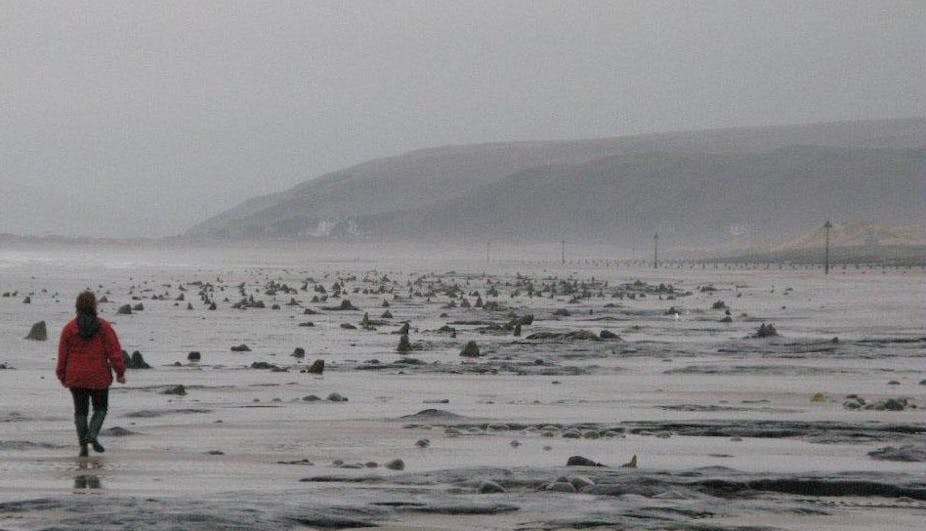It is said that if you listen carefully on the shores of Aberdyfi in northwest Wales you can hear the bells of the drowned church of Maes Gwyddno ringing a sad lament beneath the waves.
Such tales suggest that catastrophic flooding is nothing new for the coastal communities of Britain. In fact diluvian myths abound in cultures across the world: the 700BC Epic of Gilgamesh, Babylonian accounts of a Great Flood, Manu’s building of the great boat in Hindu mythology, Zeus’ punishment of humanity using a great flood, and of course the tale of Noah from the Bible – all these indicate the widespread effects of rapid sea level change.
In England, dredging has started on the sodden Somerset Levels and the clear-up continues after the recent winter storms to restore rail services at Dawlish. In Wales, authorities have promised that Aberystwyth Promenade will re-open for the Easter break. Weeks of severe storms and coastal flooding have generated considerable debate on the nature sea level change and levels of storminess, and the ability of modern society to adapt.
Similar flooding disasters are recorded in British medieval history. The late 12th-century chronicler, Giraldus Cambrensis, also known as Gerald of Wales, noted a great storm that stripped the sand from Newgale beach in Pembrokeshire, exposing prehistoric submerged forests which he interpreted as signs of the Biblical flood.
As it happens, this event was repeated this winter when storms again breached the shingle bar and re-exposed these ancient forests. The tale of Cantre’r Gwaelod, or the “Drowned Hundred” appears in the 13th century manuscript, the Black Book of Carmarthen, alongside infamous poems of Arthur and Merlin.
Protected from inundation by floodgates, this coastal kingdom was forever lost to the sea – flooded when the hapless gate-keeper, Seithenyn, in a drunken stupor forgot to close the flood gates. Other versions of the myth implicate the fairy priestess, Mererid. Similar tales recount loss of lands at Helig ap Glanawg in the Conwy estuary; the drowning of the Breton city of Ys again associated with drunkenness, catastrophic breaching of sea defences and mournful under-sea church bells; and the drowned site of the final battle between Arthur and Mordred at Lyonesse, the lost land bridge between Cornwall and the Isles of Scilly.
Some of these tales may be linked to actual past events of cataclysmic coastal flooding such as the great tidal flood recorded by contemporary chronicles in AD 1099, an event that also swamped the banks of the Thames and brought great sand banks into coastal low-lying Kent. Others may have been inspired by observation of submerged forests, exposed by contemporary coastal storms, but dating to more ancient prehistoric times.

Remarkably, there is ample archaeological evidence for submerged lands, not least the astonishing submerged forest visible at Borth in West Wales, radiocarbon-dated to the Neolithic period, and peat exposures at Tywyn with their intricate system of interlocking rectangular basins where people of the past carefully cut peat for fuel.
My colleagues from the University of Wales Trinity Saint David and I are currently monitoring coastal peat exposures for fresh evidence. The recent discovery of human footprints along with heat-cracked stones at Borth complements the discovery of a wattled trackway by the Royal Commission on Ancient and Historic Monuments Wales. The work of Professor Martin Bell and others in the Severn Estuary has also emphasised the seasonal exploitation of a rich mosaic of coastal wetland resources since the Middle Stone Age period.
Flood has long been part of human heritage and myth, used as symbolic narrative – often of a vengeful god’s retribution upon an undeserving civilization. The metaphor is one of an act of cleansing or purification. But in the Welsh versions of the flood tradition we can see something more. The catastrophe is caused by delinquency, by those who have failed in their duty to keep the sea out, to prevent the loss of life and property. The motif is one of blame, guilt, and loss. This is reinforced and given legitimacy by linking mythical characters to historic individuals, so the historic 6th-century poet Taliesin was reputedly adopted by the mythical Elffin, son of Gwyddno Garanhir, of the sunken land. Flooding is the fault of humans, we have brought it upon ourselves.
Perhaps a 12th-century Professor Richard Tol would have disapproved of the Cantre'r Gwaelod story as “alarmist” too. The withdrawal of his support from the latest IPCC report because of its “four horses of the apocalypse” message is underpinned by messages from the archaeological record. Catastrophe in myth acts as a parable, a warning not to take our hand off the tiller. The reality for our modern coastal communities is no less destructive but: “Seasonal exploitation of a rich mosaic of coastal wetland resources” doesn’t make such a good story.
In medieval times, floods of the day and those revealed by prehistoric submerged forests were used as metaphors, moral tales linked to ungodliness and catastrophe. Today, science provides us with new insights. Catastrophic coastal change may be an intrinsic part of the earth system, potentially aggravated by our contamination of it. Are the floods of today a parable of our moral delinquency, the result of our profligate, unsustainable misuse of the earth’s resources?

